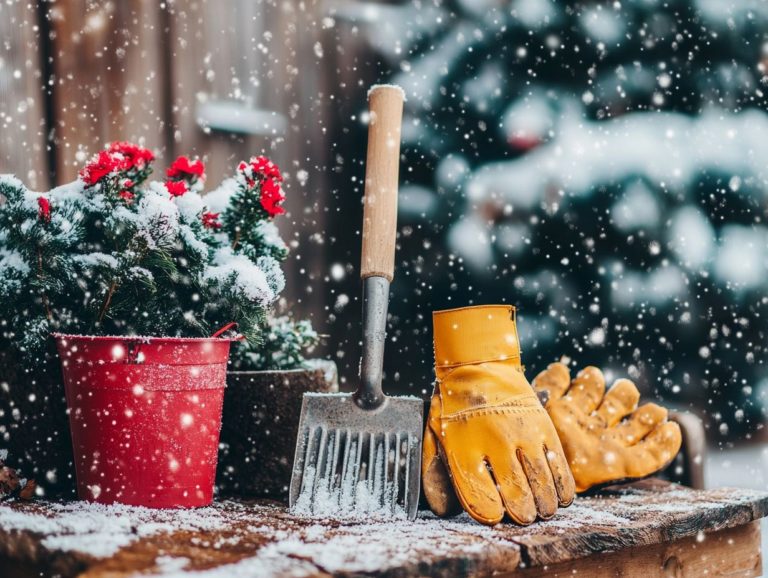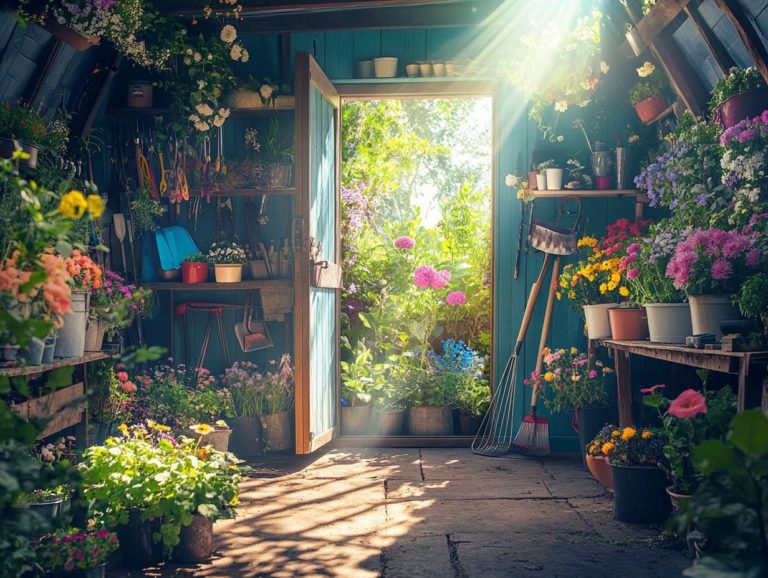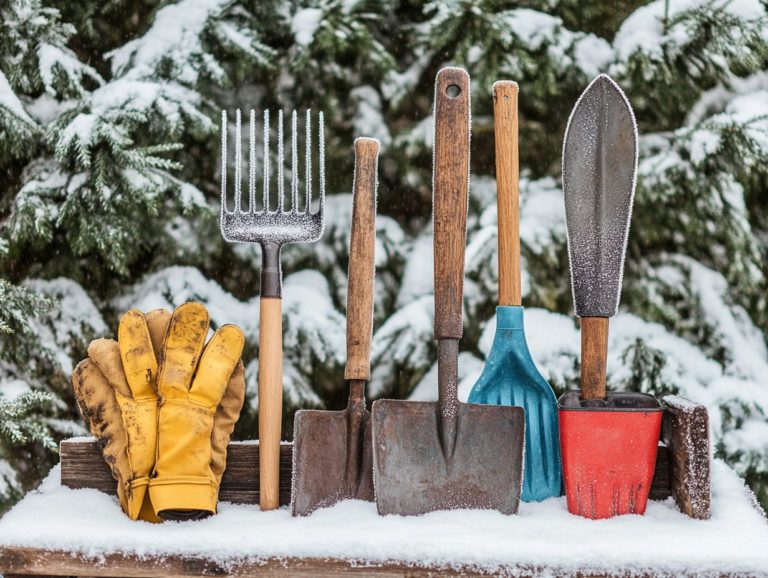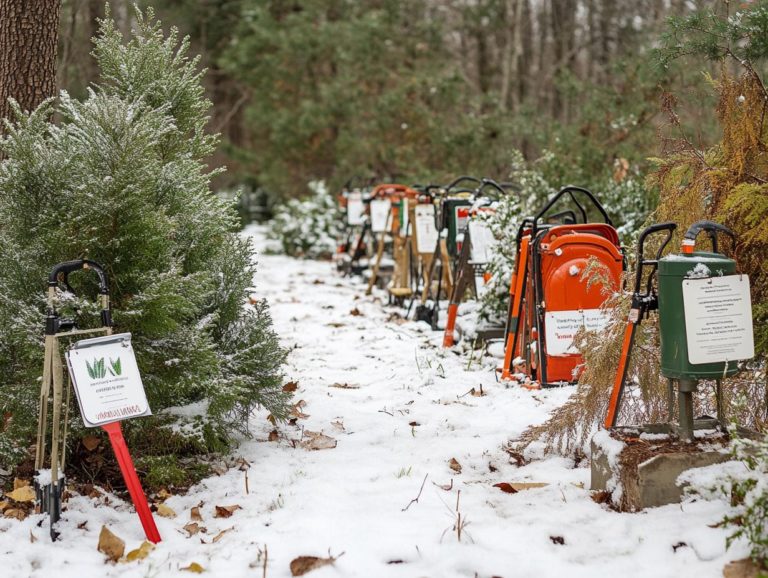5 Best Cold-Weather Garden Accessories
As temperatures plummet, gardening in winter can pose quite the challenge. However, with the right accessories in your toolkit, you can ensure your plants not only survive but thrive in those chilly conditions.
This guide showcases the top 15 essential cold-weather gardening accessories, ranging from dependable garden gloves to efficient watering cans.
Dive into how each item can elevate your gardening experience, providing comfort and protection for both you and your cherished plants.
Uncover the myriad benefits these tools offer, and maximize your gardening pursuits, regardless of the season!
Contents
- Key Takeaways:
- 1. Garden Gloves
- 2. Hand Pruners
- 3. Garden Kneeler
- 4. Plant Covers
- 5. Garden Cart
- 6. Watering Can
- 7. Garden Shovel
- 8. Garden Apron
- 9. Seedling Heat Mat
- 10. Garden Thermometer
- 11. Garden Tool Organizer
- 12. Garden Trowel
- 13. Garden Sprayer
- 14. Garden Hose
- 15. Garden Bucket
- What Are the Benefits of Using Cold-Weather Garden Accessories?
- Frequently Asked Questions
- What are the 5 best cold-weather garden accessories?
- What is a garden cloche and how does it help in cold weather?
- Why should I use frost covers in my garden during winter?
- What are heated plant mats and how do they benefit my cold-weather garden?
- Do I need a greenhouse kit for my cold-weather garden?
- Can hand warmers be used in the garden during winter?
Key Takeaways:
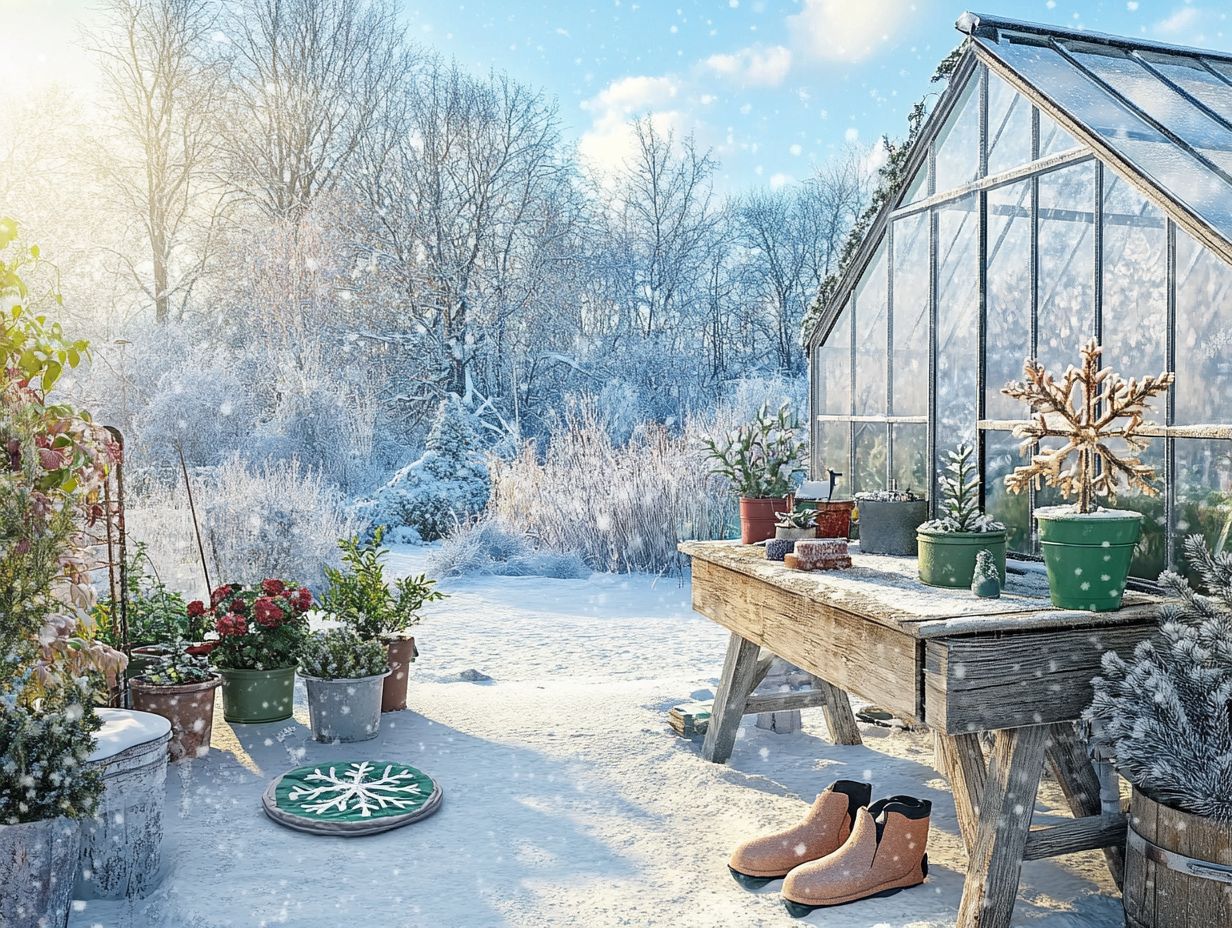
- Invest in quality garden gloves to shield your hands from cold and thorns!
- Use hand pruners to trim and shape your plants during the winter months!
- Employ a garden kneeler for comfort while gardening in colder temperatures!
Gear up now and make winter gardening a joy!
1. Garden Gloves
Garden gloves are essential for you as a gardener, especially during the cold-weather gardening season. They protect your hands from harsh elements and help you cultivate your vegetable gardens effectively.
The right gloves can elevate your gardening experience, whether you re planting crops or harvesting fresh vegetables. They ensure that you maintain the productivity of your organic gardening efforts even in winter.
At Our Stoney Acres in Utah, Rick Stone highlights the significance of quality garden gloves for comfort and safety during the growing season.
When selecting gloves for those chillier months, look for insulated options made from materials like neoprene (a stretchy, insulating material) or Thinsulate (which offers warmth without bulk). These materials provide both warmth and dexterity.
Some gloves come with rubberized palms for a firm grip, making it easier to handle tools or slippery plant materials while keeping warm.
For tasks like pruning or weeding, consider gloves with reinforced fingertips to protect against sharp thorns. It’s wise to choose gloves with water-resistant features to keep your hands dry in wet conditions.
Knowing when to use lightweight versus heavy-duty options helps you tackle any winter project efficiently.
2. Hand Pruners
Hand pruners are an essential tool in your cold-weather gardening arsenal. They enable you to maintain and shape your plants effectively, even when growth has slowed during winter months.
These versatile instruments play a vital role in keeping your plants healthy by helping you remove dead or damaged branches, promoting better airflow and preparing for strong growth in spring.
You ll find various types of hand pruners at your disposal bypass pruners are perfect for live stems, while anvil pruners excel at tackling tougher, woody materials.
By understanding the specific needs of your plants, you can confidently select the right pruner for each task. Regular cleaning and proper maintenance can significantly extend the lifespan of these tools, ensuring they remain your trusty companions for many winters to come.
3. Garden Kneeler
A garden kneeler can transform your cold-weather gardening experience! It gives you a comfortable spot to kneel while planting crops or tending to your vegetable gardens.
This thoughtful tool makes winter gardening a lot less strenuous. With excellent support for your knees, it significantly reduces the strain on your back, allowing you to enjoy longer, more pleasant gardening sessions.
When searching for a quality kneeler, look for one with a sturdy frame, generous cushioning, and a lightweight design for easy transport. A kneeler equipped with handles provides extra stability when rising after kneeling.
During the colder months, using a garden kneeler not only insulates you from the chill of the ground but also simplifies tasks like bulb planting or mulching, enhancing both efficiency and comfort throughout your gardening endeavors.
4. Plant Covers
Plant covers are key to extending your growing season and protecting your crops from harsh winter conditions. They are an essential part of winter gardening, including cold frames and row covers. Whether you choose cold frames, row covers, or mini hoop houses, each option offers unique benefits to safeguard your garden.
Using these plant covers in your garden, as recommended by Rick Stone at Our Stoney Acres in Utah, can elevate your organic gardening efforts. You’ll enjoy a fresh harvest even in winter’s chill!
Row covers act as protective blankets against frost while allowing sunlight to filter through. This creates a microclimate that’s perfect for growth. Cold frames trap heat, providing a cozy environment for seedlings and delicate plants. Mini hoop houses offer a semi-permanent solution for longer growing seasons.
By utilizing these various plant covers, you can enhance plant health and boost your overall yield, ensuring your garden will flourish even during the coldest months. The benefits of these covers go beyond mere survival; they foster robust growth and amplify the flavors of your winter vegetables.
5. Garden Cart
A garden cart is an essential tool for any gardener, especially when facing the unique challenges of cold-weather gardening. It simplifies transporting tools, plants, and freshly harvested vegetables.
This versatile asset boosts efficiency by helping you organize various supplies and minimizing the number of trips needed for both indoor and outdoor gardening tasks. Whether you re in a vegetable patch or caring for potted plants indoors, a garden cart streamlines the process of moving soil, fertilizers, and other essentials.
These carts often have compartments that provide space for smaller items. This thoughtful design keeps everything organized and creates a more productive gardening experience.
6. Watering Can
A watering can is essential for ensuring your plants receive the moisture they need, especially during indoor gardening in the colder months. Traditional watering methods might not suffice.
Mastering proper watering techniques is vital during this time, as plants can still lose moisture due to dry indoor air and heating systems. Different designs of watering cans can enhance your routine. Those with long spouts allow you to water with precision, directing moisture exactly where it s needed and minimizing waste.
To maintain consistent moisture levels in winter, regularly check the soil moisture and consider using a moisture meter, a tool that helps you gauge how wet your soil is. Grouping your plants together can also create a more humid microenvironment that promotes their overall health.
7. Garden Shovel
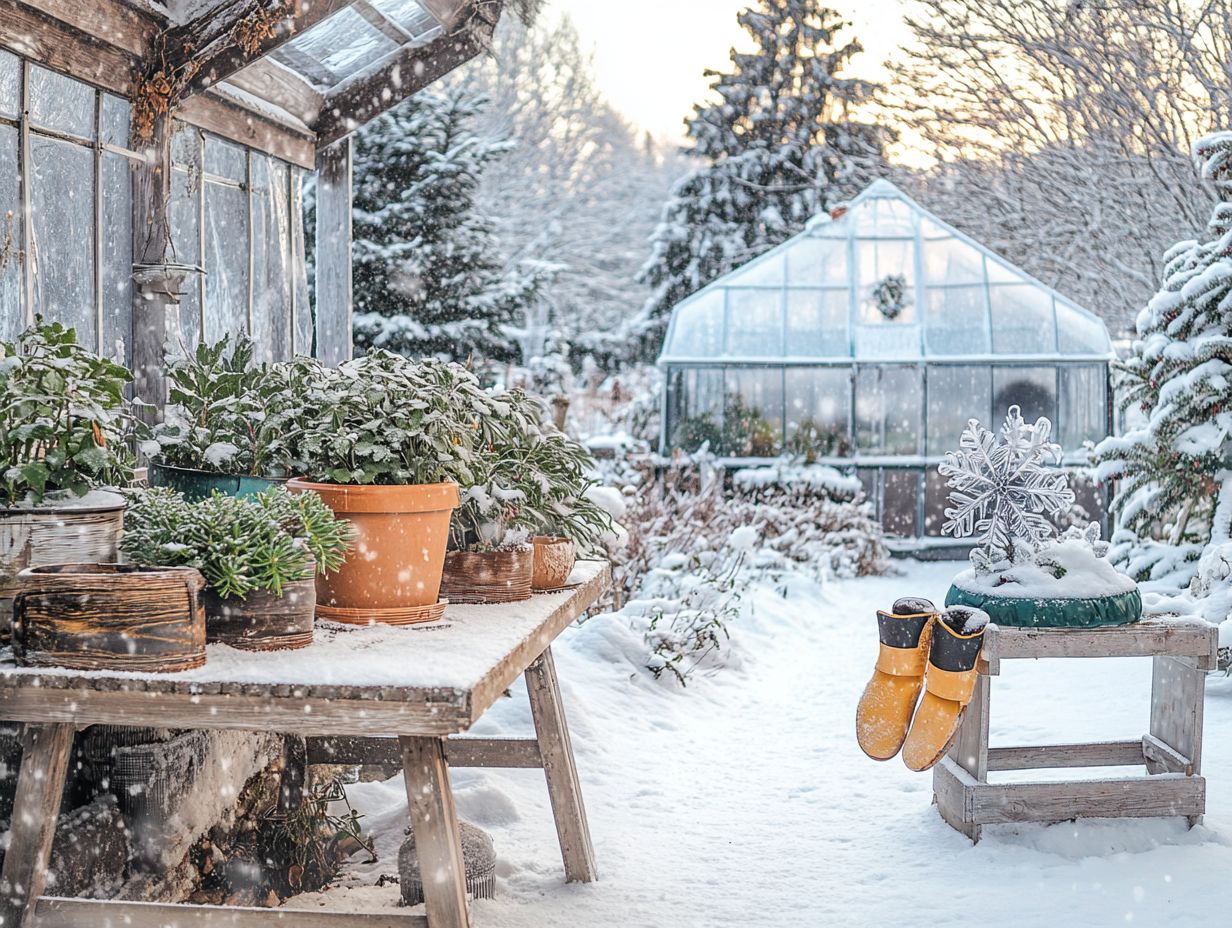
A garden shovel is a tool you can t overlook when planting crops during the colder months. This tool allows for efficient soil turnover and prepares the ground for a vibrant growing season ahead.
Various types of garden shovels exist, each designed for specific needs. For example, a standard shovel excels at digging and moving larger amounts of soil, while a spade is perfect for edging and making precise cuts. A narrow trench shovel is ideal for planting bulbs, and a pointed shovel helps break through tough ground.
In winter planting, these shovels play a crucial role in aerating the soil, improving drainage, and distributing nutrients evenly. By selecting the right type, you can enhance soil structure and promote healthier plant growth, even in challenging winter conditions.
Don t wait try out these tips for winter gardening today and enjoy a bountiful harvest!
8. Garden Apron
A garden apron is an important tool for any gardener. It offers handy pockets for all your tools, ensuring that everything you need is always within arm’s reach.
This garment does more than just keep your essentials neatly organized; it also shields your clothing from dirt and moisture. With thoughtfully designed pockets for tools, gloves, and seed packets, it boosts your efficiency by cutting down on the time spent hunting for misplaced items.
These aprons can be made from strong materials like canvas or waterproof fabrics such as nylon. These materials provide warmth and comfort, making them an excellent choice for anyone who enjoys spending time outdoors.
9. Seedling Heat Mat
A seedling heat mat is a valuable investment for your indoor gardening. It provides the warmth necessary to promote healthy germination during chillier months.
These mats gently elevate the soil temperature, which refers to how warm the soil is, affecting seedling growth. This is especially helpful if you’re gardening in regions where cold conditions can stifle seedling growth.
Incorporating heat mats into your gardening routine significantly boosts your success rate. They eliminate the uncertainty that comes with cold soil temperatures and promote vigorous root development, leading to stronger plants.
Using heat mats can effectively extend your growing season, allowing you to cultivate a wider variety of plants than you might have thought possible. Get ready for a thriving garden!
10. Garden Thermometer
A garden thermometer is an essential tool for any gardener. It helps monitor soil and air temperatures during the chilly gardening months to help create the perfect environment for your plants.
By accurately tracking these temperatures, you’re enabled to make informed decisions about when to plant seeds. This tool offers crucial insights into potential frost occurrences or the risk of heat stress on tender young plants.
Placement is everything; burying the thermometer in the soil or positioning it in a shaded spot will provide the most reliable readings. Armed with this data, you can develop effective strategies for crop protection and overall garden health.
11. Garden Tool Organizer
A garden tool organizer can elevate your gardening experience. It enhances both efficiency and organization, especially during brisk cold-weather months, making it easier to access the top essential cold-climate plant food tools.
As the air turns chilly, there s little more exasperating than sifting through a chaotic heap of equipment to locate an essential tool. Fortunately, you have a range of garden tool organizers at your disposal, including:
- Wall-mounted racks
- Portable tool bags
- Rolling carts
Each option accommodates various space limitations and gardening preferences. The advantages include improved workspace tidiness, time savings, and a significant reduction in stress while tending to your outdoor sanctuary.
When selecting the ideal organizer for your gardening tasks, consider your available space, the types of tools you frequently use, and whether you require mobility. Explore your gardening options today!
12. Garden Trowel
A garden trowel is a must-have for planting crops and caring for your vegetable garden. In colder months, precision is crucial!
With various styles available pointed, wide-blade, and transplant trowels each design is crafted for specific gardening tasks. A pointed trowel excels at breaking up compacted soil, making it easy to prepare the ground. In contrast, a wide-blade trowel is perfect for scooping out larger quantities of soil or compost, ideal for filling holes and beds.
In cold-weather gardening, these tools are even more vital. They help you work efficiently, ensuring your plants are firmly established and protected against frost damage. By choosing the right trowel, you enhance both your planting and maintenance tasks, making your gardening experience smoother and more effective.
13. Garden Sprayer
A garden sprayer is a versatile tool that can elevate your organic gardening practices. It allows you to apply fertilizers or pest control solutions with ease, even in chilly conditions.
Sprayers come in various types: handheld, backpack, and wheeled. Each is designed for different tasks and garden sizes.
- Handheld sprayers are ideal for small plots, enabling precise treatment application without overwhelming your plants.
- Backpack sprayers offer extended use, perfect for larger areas, while wheeled options are great for expansive gardens.
In your organic gardening efforts, using these sprayers for solutions made from natural ingredients nurtures your plants without harmful chemicals.
When applying treatments in colder climates, do so on days when temperatures rise above freezing and during the warmer parts of the day. This strategy guarantees optimal absorption and effectiveness.
14. Garden Hose
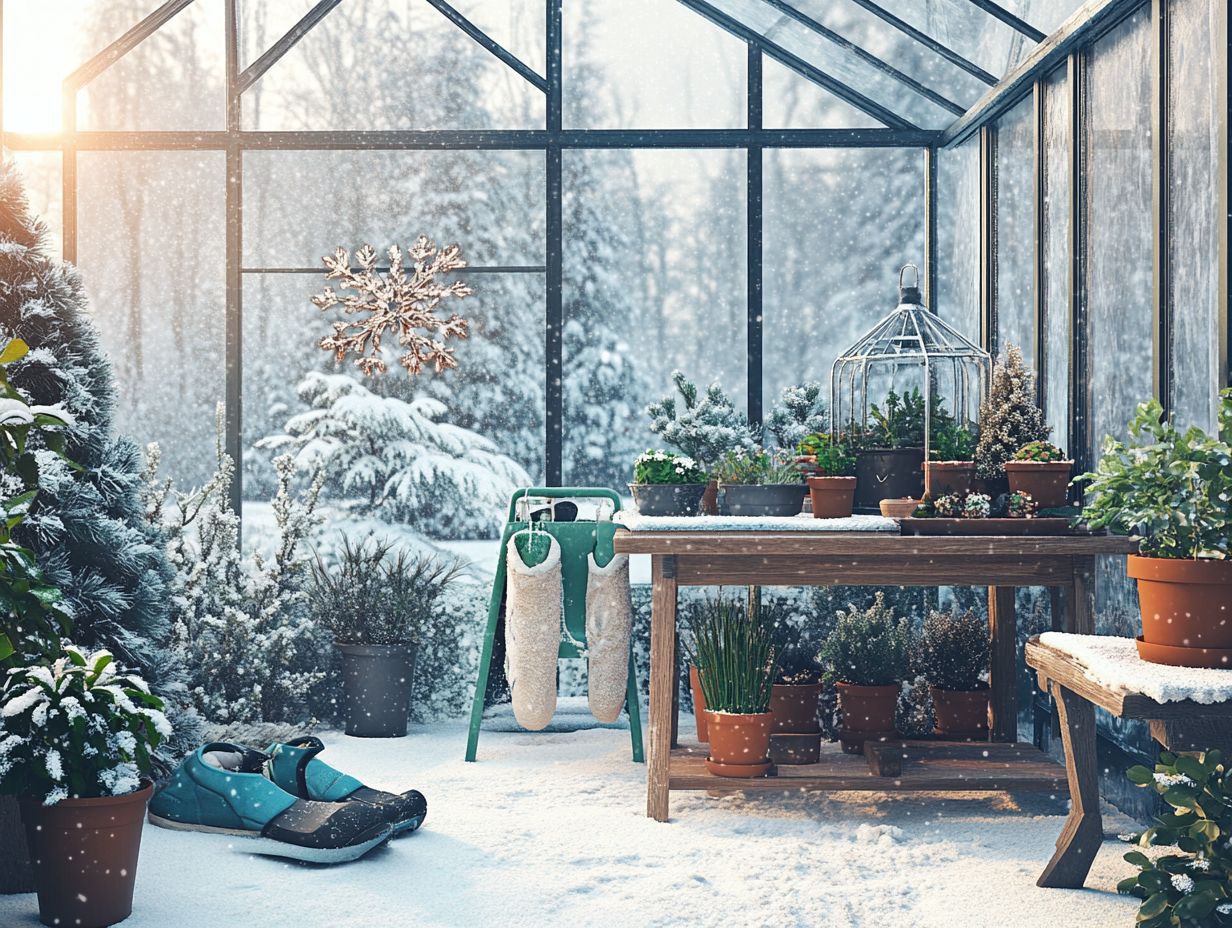
A sturdy garden hose is essential for any gardener, especially for indoor gardening and preparing your outdoor vegetable gardens for the colder months ahead.
A well-maintained hose ensures water flows freely, crucial for nurturing your plants during their dormant season (a time when plants are not actively growing). Selecting the right hose is essential in winter. Rubber or reinforced vinyl options resist low temperatures without breaking.
Implementing effective watering practices during this time is key. Water in the afternoon to give your plants a chance to absorb moisture before nighttime freezes. Using insulated covers for your garden hoses helps prevent freezing.
By taking these steps, you ensure your plants receive the necessary hydration while protecting your equipment from harsh winter conditions.
15. Garden Bucket
A garden bucket is essential for you, perfect for harvesting fresh vegetables and collecting materials. It makes your gardening tasks during chilly months much more manageable.
These versatile buckets help gather produce and make transporting supplies, soil, and compost easier. You’ll find everything organized and ready when you need it.
When caring for your winter gardens, the insulated properties of these buckets help protect your delicate plants and seedlings.
Using garden buckets for organization can truly streamline your tasks. They allow you to separate and categorize items effortlessly, whether they re seeds, cuttings, or tools. Their durable design and ease of handling can transform the often laborious work of gardening into a more efficient and enjoyable experience, no matter the season.
What Are the Benefits of Using Cold-Weather Garden Accessories?
Using cold-weather garden accessories offers you a host of benefits. They protect your plants, make your gardening tasks more efficient, and enhance your comfort during brisk winter months. For optimal results, consider the 5 must-have tools for winter gardening.
These factors are essential for successful gardening in challenging conditions. Tools like garden gloves, hand pruners, and plant covers can significantly extend your growing season and help you grow more vegetables.
Among resilient options are collards, Swiss chard, and Napa cabbage, enhancing your overall gardening experience.
The right accessories shield your delicate crops from frost and minimize the risk of plant stress, allowing for healthier growth. For example, insulated gloves protect your hands from the biting cold while giving you the dexterity needed for precise pruning or planting. Additionally, using the 5 best containers for cold-climate gardening can further enhance your gardening efforts in challenging conditions.
Row covers create a small area where the climate is different, encouraging earlier germination while keeping pesky critters at bay.
By embracing these advancements, you can adapt your gardening practices to remain productive and comfortable, even as temperatures drop. Consider using 5 must-have winter gardening apps to help you along the way. You can look forward to a thriving garden come spring!
How Do These Accessories Help Protect Plants in Cold Weather?
Cold-weather gardening accessories are essential for safeguarding your plants against winter’s challenges. Consider investing in the 5 best cold-weather garden kneelers, as they provide insulation, retain moisture, and offer shelter.
This ensures that your vegetable gardens remain healthy and vibrant during colder months. By employing tools like cold frames, row covers, and mini hoop houses, you can significantly bolster your garden’s resilience.
Cold frames serve as mini-greenhouses, creating a controlled environment that traps heat. This allows you to start seedlings early. Row covers act as a lightweight blanket, protecting tender crops from frost while still permitting sunlight to filter through.
Mini hoop houses are versatile structures that create a microclimate, accommodating various plants and extending your growing season.
Collectively, these accessories shield your garden and promote vigorous growth, allowing you to use the top 10 must-have tools for winter gardening to cultivate a thriving harvest even as temperatures plummet.
What Are the Different Types of Garden Gloves and How Do They Differ?
There s a world of garden gloves, each crafted for specific tasks and conditions. You ll find everything from thick, insulated gloves ideal for cold-weather gardening to lightweight options perfect for delicate work.
Understanding this variety can significantly enhance your gardening experience. For example, leather gloves offer durability for heavy-duty tasks like pruning thorny bushes.
In contrast, cotton gloves are just right for light weeding or planting seeds. Waterproof options are a must when working in wet conditions, protecting against moisture and dirt.
If you’re gardening in warmer weather, gloves made from breathable materials will keep your hands cool and comfortable.
When selecting the right pair, think about the specific gardening activities you ll be doing. Opt for thicker gloves to protect against sharp objects and lighter ones for tasks that require more dexterity.
This strategy ensures safety and efficiency in every gardening endeavor.
How Can a Garden Kneeler Make Gardening More Comfortable in Cold Weather?
A garden kneeler significantly enhances your comfort during chilly gardening sessions. It offers the support you need while kneeling, allowing you to work longer without succumbing to fatigue.
This essential accessory cushions your knees and helps you maintain proper body posture. This effectively reduces strain on your back and joints.
When pruning shrubs or planting bulbs, the kneeler serves as a barrier against the cold ground, creating a warmer workspace.
In frigid months, using a garden kneeler makes tasks like weeding or mulching far more bearable. Its dual functionality often allows you to flip it over for a comfortable seat.
This adds immense value, providing the perfect spot for your frequent breaks. With this handy tool, you can ensure that gardening remains enjoyable and productive, even when the weather is less than forgiving.
Get your gear ready today to enjoy gardening all winter long!
What Are the Different Types of Plant Covers and Their Uses?
You have a variety of plant covers, including cold frames, row covers, and mini hoop houses. Each is designed for specific purposes in cold-weather gardening, and using the right tools, such as the 5 essential tools for indoor winter gardening, can enhance your success.
These covers do more than shield plants from frost. They create a stable microclimate that nurtures growth.
Cold frames quickly trap the sun’s heat during the day, giving your tender seedlings a warm hug on chilly days.
Row covers are made from lightweight fabric. They protect against pests while allowing sunlight and moisture to reach your plants, making them perfect for leafy greens and other cold-hardy crops.
Mini hoop houses offer robust support for larger plants like tomatoes and peppers. They create a snug environment to withstand winter chill.
Choosing the right cover significantly enhances your plants’ resilience. This positions them for a productive growing season when spring arrives.
Frequently Asked Questions
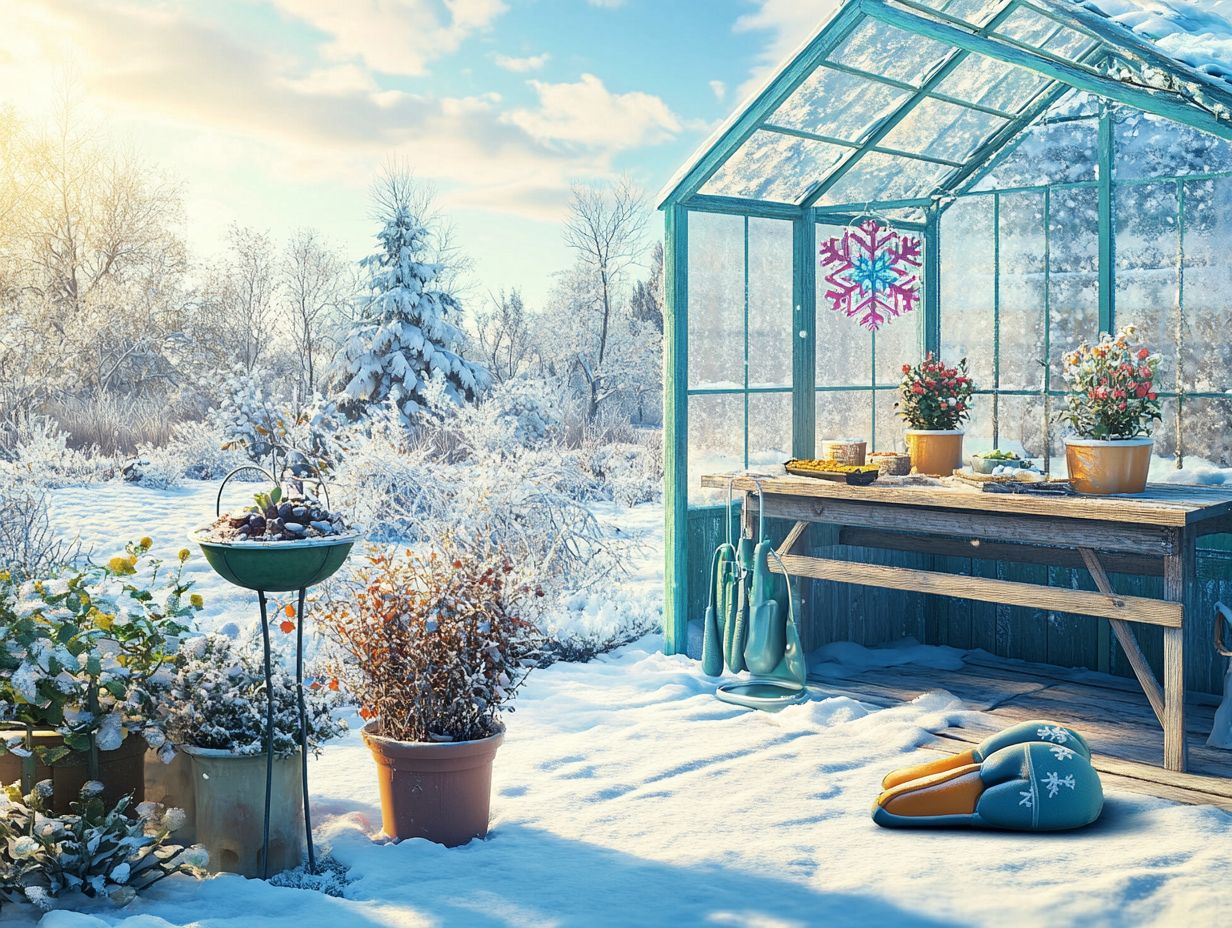
What are the 5 best cold-weather garden accessories?
The best accessories include:
- Garden cloches
- Frost covers
- Heated plant mats
- Greenhouse kits
- Hand warmers
What is a garden cloche and how does it help in cold weather?
A garden cloche is a protective cover for individual plants or small garden beds. It helps to retain warmth, protect plants from frost, and promote growth in cold weather.
Why should I use frost covers in my garden during winter?
Frost covers provide an extra layer of insulation for plants, protecting them from freezing temperatures and harsh winds. They can also help to extend the growing season.
What are heated plant mats and how do they benefit my cold-weather garden?
Heated plant mats are electric mats that provide gentle heat to plants, promoting root growth and protecting them from freezing temperatures. They are especially beneficial for starting seedlings in cold weather.
Do I need a greenhouse kit for my cold-weather garden?
A greenhouse kit is not necessary, but it can greatly benefit your cold-weather garden. It provides a controlled environment for plants, protecting them from extreme cold and allowing you to grow a wider variety of plants during winter.
Can hand warmers be used in the garden during winter?
Yes, hand warmers can be used in the garden during winter to keep your hands warm and comfortable while working outside. They can also be placed in pots or under covers to provide extra warmth for plants.

